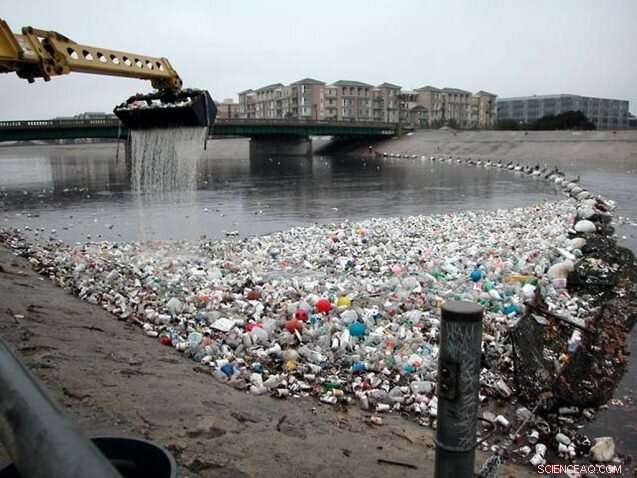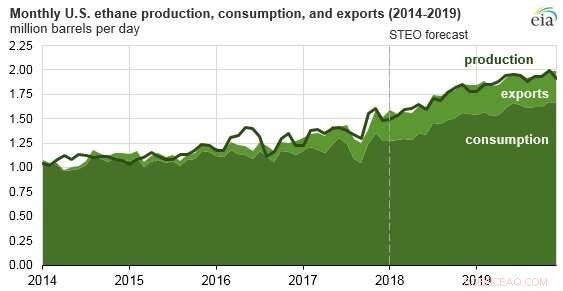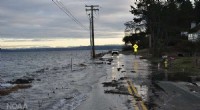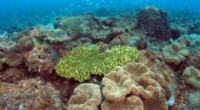
Wetenschap
Er komt meer plastic aan:wat het betekent voor klimaatverandering

De L.A.-rivier. Foto:Kqedquest
Met de recente fracking-boom die lage gasprijzen veroorzaakte, fossiele brandstofbedrijven zoeken naar andere manieren om hun winst te vergroten - door meer plastic te maken. Net nu de wereld het enorme probleem van plasticvervuiling begint aan te pakken, deze bedrijven verdubbelen plastic, met grote potentiële gevolgen voor klimaat en milieu.
De overvloed aan aardgas heeft geleid tot de laagste gasprijzen sinds 2016. sommige fossiele brandstofbedrijven worden gedwongen om boorplatforms te sluiten en faillissementsbescherming aan te vragen. Grote bedrijven zoals Exxon Mobil, Shell en Saudi Aramco, die tekenen zien van een komende afname van het gebruik van fossiele brandstoffen, compenseren de lage prijzen door te investeren in plasticproductie, omdat kunststoffen van olie worden gemaakt, gas en hun bijproducten. Als resultaat, het World Economic Forum verwacht dat de productie van plastic tegen 2040 zal verdubbelen.
Aardgas bevat ethaan, dat is een bouwsteen van plastic. Omdat de VS zoveel ethaan heeft gewonnen met zijn aardgas, meer dan $ 200 miljard is geïnvesteerd in 333 nieuwe chemische en plastic projecten, vanaf eind 2019.
Judith Enck, voormalig regionaal EPA-directeur en oprichter van Beyond Plastics, heeft gezegd dat 2020 een kritiek jaar is omdat veel van de nieuwe plasticproductiefaciliteiten in de VS in het vergunningsproces zitten; "Als zelfs maar een kwart van deze ethaankraakinstallaties wordt gebouwd, " ze zei, "het sluit ons op in een plastic toekomst waar we moeilijk van zullen herstellen." Een analist van het data- en analysebedrijf IHS Markit zei dat tenzij de plasticproductie wordt vertraagd, "ze zullen gewoon iets anders vinden om in plastic te verpakken."
Ethaan crackers
Ethaan is een geur- en kleurloos bestanddeel van aardgas. Om kunststof te maken, bedrijven scheiden het van het aardgasmengsel en transporteren het in vloeibare vorm via pijpleidingen naar een "ethaankraker, " een grote industriële fabriek die intense hitte gebruikt om ethaanmoleculen te kraken of af te breken. Deze moleculen veranderen vervolgens in ethyleen, een basisbouwsteen van de petrochemische industrie die wordt gebruikt om harsen te maken, lijmen, Chemicaliën, en kunststoffen. In het proces, ethaankrakers kunnen verontreinigende stoffen uitstoten zoals stikstofoxiden, zwaveldioxide en fijnstof, evenals benzeen, die kankerverwekkend is, en vluchtige organische stoffen die kunnen reageren met zonlicht om ozon op leefniveau te vormen.
De Verenigde Staten produceren al ongeveer 40% van 's werelds op ethaan gebaseerde petrochemicaliën en zijn de grootste exporteur van ethaan, verkopen aan Noorwegen, het VK., en Schotland, en naar China en India, waar de vraag naar plastic stijgt.
Het ministerie van Energie (DOE) verwacht dat in 2025, het oosten van de VS, inclusief Appalachen, zal 20 keer meer ethaan produceren dan in 2013.
in 2018, DOE heeft een rapport gepubliceerd over het potentieel voor Appalachia om een nieuwe "ethaanhub" te worden vanwege de schaliebronnen van Marcellus en Utica, en de regering-Trump prijst de plastic- en petrochemische industrie aan als het volgende grote ding voor de regio.
Ohio, Pennsylvania, en het aandeel van West Virginia in de Amerikaanse aardgasproductie is gestegen van 2% in 2008 naar 27% in 2017. IHS Markit verwacht dat deze drie staten, ook bekend als de Shale Crescent, zal tegen 2040 37% van het aardgas in de VS leveren, genoeg om vijf grote ethaankrakers te ondersteunen. Shell bouwt momenteel een ethaankraker van $ 6 miljard, 25 mijl ten noordwesten van Pittsburgh.
Er zijn ook nieuwe petrochemische fabrieken gepland in de buurt van de Gulf Coast van Texas en Louisiana en de Lower Mississippi River, een gebied dat al "Cancer Alley" wordt genoemd vanwege de giftige uitstoot van de bestaande petrochemische fabrieken. Twee grote ethaankrakers kwamen in december online aan de Gulf Coast en binnenkort zullen twee kleinere faciliteiten worden geopend.
Plastic proliferatie en vervuiling
De jaarlijkse vraag naar plastic is sinds 2000 bijna verdubbeld. En de groeiende wereldbevolking, verbetering van de economische omstandigheden en technologische vooruitgang zullen in de toekomst nog meer vraag naar kunststoffen creëren, Dat blijkt uit een rapport van het Internationaal Energie Agentschap (IEA). Momenteel, de VS en andere ontwikkelde landen tot 20 keer zoveel plastic per persoon gebruiken als India, Indonesië en andere ontwikkelingslanden.
De VS produceren ook meer plastic verpakkingsafval per hoofd van de bevolking dan enig ander land. Deze plastic wegwerpverpakkingen vormen 40% van al het plastic, waarvan de meeste op stortplaatsen terechtkomen; de rest wordt verbrand of gerecycled. Een rapport van het Centrum voor Internationaal Milieurecht (CIEL), Kunststof &Klimaat, constateerde dat vanaf eind 2015 8, Er is wereldwijd 300 miljoen ton nieuw plastic geproduceerd, waarvan tweederde in het milieu blijft.
Elk jaar, bijna 10 miljoen ton plastic belandt in de oceaan, waar het wordt geconsumeerd door zeedieren, en plastic afval wordt zelfs op de meest afgelegen plekken op aarde gevonden op stranden. Plastic vervuilt ook het land, vooral op boerderijen waar zuiveringsslib als kunstmest wordt gebruikt.
Bisfenol A (BPA), een chemische component in het plastic van sommige waterflessen en de bekleding van blikjes, is gevonden in het navelstrengbloed van negen van de tien zuigelingen en in de urine van 95% van de volwassen Amerikanen die zijn getest. Sommige onderzoeken wijzen uit dat het de hormoon- en voortplantingssystemen kan verstoren. Microplastic en kleine plastic vezels zijn gevonden in honing, suiker, bier, bewerkte voedingsmiddelen, schaaldieren, zout, wasmiddel, flessenwater en kraanwater; echter, de gezondheidseffecten van microplastics zijn nog onduidelijk.
De klimaatimplicaties van plastic
Plastic vormt niet alleen een enorm vervuilingsprobleem, het verergert ook de klimaatverandering. Het CIEL-rapport waarschuwt dat de uitstoot van broeikasgassen door plastic ons vermogen om de wereldwijde temperatuurstijging onder de 1,5 C te houden in gevaar brengt. Als de plasticproductie op het huidige traject blijft, tegen 2030, de uitstoot van broeikasgassen door plastic kan oplopen tot 1,34 miljard ton per jaar, equivalent aan de uitstoot van 300 nieuwe kolengestookte elektriciteitscentrales van 500 MW. Dit komt omdat meer dan 99% van het plastic gemaakt is van fossiele brandstoffen, zowel aardgas als ruwe olie - en omdat plastic in elke fase van zijn levenscyclus leidt tot de uitstoot van broeikasgassen.
Extractie en transport
De uitstoot van broeikasgassen ontstaat in eerste instantie wanneer bebost land en velden worden gekapt om plaats te maken voor putplaten en pijpen om naar olie en aardgas te boren.
Als een derde van de 19,2 miljoen acres in de VS die zijn vrijgemaakt voor extractie ooit bebost was, het betekent dat bijna 1,7 miljard ton koolstofdioxide is uitgestoten als gevolg van ontbossing; Bovendien, het vermogen van het beboste land om elk jaar nog eens 6,5 miljoen ton koolstof op te nemen, is geëlimineerd.
Het frackingproces stoot methaan uit, een broeikasgas dat meer dan 20 jaar, houdt meer dan 84 keer meer warmte vast in de atmosfeer dan koolstofdioxide. Methaan ontstaat door affakkelen en lekkage, die overal kan voorkomen, van de put tot de eindgebruiker.
Emissies worden ook geproduceerd door de brandstof te verbranden om de boorapparatuur te laten werken.
in 2015, uitstoot van winning en transport voor kunststofproductie bedroeg 9,5-10,5 miljoen ton CO 2 alleen al in de VS - het equivalent van de uitstoot van 2,1 miljoen personenauto's die een jaar lang worden bestuurd.

Groei in ethaanproductie, consumptie en export. Krediet:USEIA
Verfijning en fabricage:
"Plastic is een van de meest energie-intensieve materialen om te produceren, " volgens het hoofd van CIEL. Het kraken van ethaan is energie-intensief vanwege de hoge benodigde warmte, en produceert aanzienlijke emissies, net als de chemische raffinageprocessen die andere kunststoffen maken.
De jaarlijkse uitstoot van de nieuwe ethaankraker van Shell en een ethyleenfabriek van ExxonMobil in Baytown, TX zullen naar verwachting gelijk zijn aan het toevoegen van bijna 800, 000 nieuwe auto's op de weg. Greenhouse gas emissions from the Shell plant alone could cancel out all the benefits of nearby Pittsburgh's carbon reduction measures. And these are just two of the over 300 planned petrochemical projects being built in the U.S. mainly to produce plastic and plastic feedstocks.
Discarded plastic
After it's used, plastic is incinerated, recycled or ends up in a landfill.
Carbon from the fossil fuel feedstock is locked into plastic products and emitted when plastic is incinerated or decomposes. in 2015, 25% of global plastic waste was incinerated; in the U.S., emissions from plastic incineration were equivalent to 5.9 million metric tons of CO 2 , equivalent to the emissions from heating 681, 000 homes for a year.
Only about 8.4% of plastic is recycled. Maar, according to scientists from UC Santa Barbara, even recycling plastic produces greenhouse gas emissions, as fossil fuels are combusted to run the machines that shred plastic waste and heat it up to make other products.
Plastics in the environment, such as those that persist in landfills and litter coastlines all over the world, have been found by University of Hawaii researchers to release the greenhouse gases methane and ethylene when sunlight hits them; Bovendien, emissions from plastic on the ocean surface increase as the plastic breaks down.
Could microplastics affect the ocean's ability to absorb carbon dioxide?
The ocean absorbs carbon dioxide from the atmosphere, thus reducing the amount of warming emissions would cause if they remained in the atmosphere. Phytoplankton in the ocean play an essential role in this process, taking carbon dioxide from the atmosphere and storing it in the ocean via photosynthesis. Scientists are currently trying to determine if microplastics in the ocean interfere with phytoplankton's ability to sequester carbon.
Joaquim Goes, a research professor at the Earth Institute's Lamont-Doherty Earth Observatory, said that although he has not seen any studies that show a direct effect of microplastics on phytoplankton, "We have seen microplastics attach onto phytoplankton under the microscope. Phytoplankton can shed extra sticky carbohydrates through photosynthesis, and plastics can attach onto the sticky material. One thing you can assume is that if you have too many microplastic particles, they compete with phytoplankton for light."
Marco Tedesco, a research professor at Lamont-Doherty Earth Observatory, who currently researches microplastic in snow and how it evolves, said that the chemicals used to make plastic could have unknown effects. "The chemicals that have been used during their lifecycle are heavily toxic and there's very little regulation about the use of these elements when it comes to plastics, " said Tedesco. "So the treatment of microplastics requires an extra level of attention because of the potential harm related to the chemicals that are used to treat plastics to make them colorful, more resilient, and impermeable. After a certain point, all the chemicals can permeate through the plastic and you don't know what the consequences are."
In feite, a 2019 study by researchers from Macquairie University in Australia studied how substances leached from plastic affected Prochlorococcus, a tiny type of phytoplankton considered a key player in the photosynthetic process that fixes carbon. Exposure to the leachate compromised its in vitro growth and photosynthetic capacity and resulted in changes in its genome.
There is still much that scientists don't know about microplastics, their impacts on the environment or what to do about them, but one thing we do know:"Anything that we produce that we put into the atmosphere or on our planet—microplastics and CO 2 —are going to be around. They're not going anywhere, " said Tedesco, "You can stop producing plastics now and you can stop emitting CO 2 nu, but the effect of what's left in the atmosphere or what's around in terms of microplastics will still be huge…. And there's really no clear technological path to the removal of microplastics at any scale."
What solutions could yield results?
Recycling
Direct, plastic recycling in the U.S. is not working well. Al decenia, the U.S. sent its recycled plastic to China, but in 2017, China banned certain types of solid waste—mainly plastics. Without a market for recycled plastic, recycling is no longer economically viable for many municipalities. The Plastic Pollution Coalition estimates that in 2018, only 2% of municipal plastic waste was recycled in the U.S. and six times more plastic was burned than recycled.
Dat jaar, the U.S. sent 68, 000 shipping containers of recycled plastic to countries such as Bangladesh, Laos, Cambodja, Philippines, Turkey, Ethiopia and Senegal—countries that are not able to handle most of their own plastic waste.
Recycled plastic used to be cheaper than new plastic, but because of the boom in petrochemical production in the U.S., and because of the demand for recycled plastic from sustainable companies, virgin plastic is becoming cheaper than recycled. Als voorbeeld, Nestelen, which is often considered one of the world's worst plastic polluters, is going to pay above market rate for recycled plastic in an attempt to reach its goal of reducing virgin plastic use by one-third by 2025.
Plastic bans
As of 2018, 127 countries had some type of legislation regulating plastic bags, according to a United Nations Environment Programme report. These bills might involve limiting the bags' manufacture or use, taxing them or regulating their disposal. Twenty-seven countries have banned certain plastic products, such as packaging, plates, cups and straws. Sixty-three countries have required extended producer responsibility for single-use plastics, where producers of the plastic are responsible, financially or physically, to deal with their disposal.
In de VS, the only federal ban on plastics is the Microbead-free Waters Act of 2015, forbidding the use of microbeads in cosmetics. Eight states have enacted other plastic restrictions, and 24 states have passed approximately 330 local plastic bag laws.
Christof Ruehl, a senior research scholar at Columbia University's Center on Global Energy Policy, is sanguine about the effectiveness of these bans and recycling. He and a colleague researched the potential impacts of a modest reduction in the demand for packaging material and a small improvement in plastic recycling. They cited three outcomes. "It brings peak oil demand forward by about five years into the mid- to late 2020s, " said Ruehl. "Secondly, it creates stranded assets because a lot of especially national companies are now heavily investing into new petrochemical facilities, because they believe plastic demand will continue rising. And thirdly—this I found really amazing—the impact of a successful campaign globally against the use of single-use plastics has a larger dent in oil demand than the dent caused by electric cars." In other words, effective regulations on plastic could reduce oil demand by at least as much as the adoption of electric cars 20 years from now.
The CIEL report studied possible solutions to the plastic pollution problem and determined that five measures would reduce greenhouse gas emissions the most and deliver environmental and social benefits:
- Ending the production and use of single-use, disposable plastic;
- Stopping development of new oil, gas, and petrochemical infrastructure;
- Promoting zero-waste communities;
- Requiring extended producer responsibility;
- Adopting and enforcing ambitious targets to reduce greenhouse gas emissions from all sectors, including plastic production.
It's important to bear in mind, echter, that even if it were possible to achieve these measures and eliminate all demand for plastic, "You will have to replace the plastic with something else, " said Ruehl. "That something else would use energy and produce carbon emissions. Glass and paper, bijvoorbeeld, are very energy-intensive. So in order to get a complete picture, you would have to study these replacements, but no one has done that yet."
Dit verhaal is opnieuw gepubliceerd met dank aan Earth Institute, Columbia University http://blogs.ei.columbia.edu.
 Diepgaande leertechnieken leren het neurale model retrosynthese te spelen
Diepgaande leertechnieken leren het neurale model retrosynthese te spelen Botdiep:Mineraal gevonden in menselijk bot kan helpen bij het bestrijden van giftige organische stoffen
Botdiep:Mineraal gevonden in menselijk bot kan helpen bij het bestrijden van giftige organische stoffen Chemische beeldvorming gebruikt om de diagnose van darmkanker te vergemakkelijken
Chemische beeldvorming gebruikt om de diagnose van darmkanker te vergemakkelijken Het delen van gegevens is de toekomst van materiaalonderzoek
Het delen van gegevens is de toekomst van materiaalonderzoek Ondersteunde vloeibare metaalkatalysatoren - een nieuwe generatie reactieversnellers
Ondersteunde vloeibare metaalkatalysatoren - een nieuwe generatie reactieversnellers
 De symbiotische relatie tussen de vijgenboom en de Amazone Fruit Bat
De symbiotische relatie tussen de vijgenboom en de Amazone Fruit Bat Technologie zal ons niet redden van klimaatverandering, maar het bedenken van nieuwe vormen van samenleving zal
Technologie zal ons niet redden van klimaatverandering, maar het bedenken van nieuwe vormen van samenleving zal Het ontrafelen van het wanneer, waar en hoe van vulkaanuitbarstingen
Het ontrafelen van het wanneer, waar en hoe van vulkaanuitbarstingen Bosranden in de tropen verhogen de CO2-uitstoot
Bosranden in de tropen verhogen de CO2-uitstoot Blootstelling aan luchtvervuiling verschuift van buiten naar binnen - dit is waarom
Blootstelling aan luchtvervuiling verschuift van buiten naar binnen - dit is waarom
Hoofdlijnen
- Hoe maak je een Bacterial Flowchart
- Waarom door deuropeningen lopen ons doet vergeten
- 'S Werelds oudste bevroren sperma werkt prima
- Haploid versus diploïde: wat zijn de overeenkomsten & verschillen?
- Samenstelling van de celwand van de zes koninkrijken
- Welke moleculen komen in de Krebs-cyclus en welke moleculen verlaten de Krebs-cyclus?
- Hoe de botten in het menselijk skelet te bestuderen
- Verschillen in mannelijke en vrouwelijke chromosomen
- Wetenschappers ontdekken pad naar verbeterde gerstkwaliteit
- Hoe synthetische biologie het milieu kan helpen

- Californië staat bekend om aardbevingen en bosbranden, maar vergeet de vulkanen niet

- Amerikaans record voor aantal dagen met vloed in 2018

- Conflict en droogte verwoesten de gewaardeerde dadelpalmen van Irak

- Subtropische koralen kwetsbaar, nieuwe studie toont

 Lood vrijgekomen bij brand Notre Dame in Parijse honing
Lood vrijgekomen bij brand Notre Dame in Parijse honing Uitgelekte chats tonen vermeende Russische spion op zoek naar hacktools
Uitgelekte chats tonen vermeende Russische spion op zoek naar hacktools Zijn massale schietpartijen een probleem van blanken?
Zijn massale schietpartijen een probleem van blanken? Onderzoekers ontwikkelen nieuwe technologie die de commercialisering van brandstofcelvoertuigen kan versnellen
Onderzoekers ontwikkelen nieuwe technologie die de commercialisering van brandstofcelvoertuigen kan versnellen Hoeveel satellieten draaien er om de aarde?
Hoeveel satellieten draaien er om de aarde? Klimaatverandering leidt tot ingrijpende, onmiddellijke en verergerende gevolgen voor de gezondheid, meer dan 120 onderzoekers zeggen:
Klimaatverandering leidt tot ingrijpende, onmiddellijke en verergerende gevolgen voor de gezondheid, meer dan 120 onderzoekers zeggen: Iceberg Corridor zorgt voor een toeristenhausse aan de oostkust van Canada
Iceberg Corridor zorgt voor een toeristenhausse aan de oostkust van Canada Consumentenrapporten:verborgen kosten voor kabel-tv kunnen u jaarlijks $ 450 extra kosten
Consumentenrapporten:verborgen kosten voor kabel-tv kunnen u jaarlijks $ 450 extra kosten
- Elektronica
- Biologie
- Zonsverduistering
- Wiskunde
- French | Italian | Spanish | Portuguese | Swedish | German | Dutch | Danish | Norway |

-
Wetenschap © https://nl.scienceaq.com

